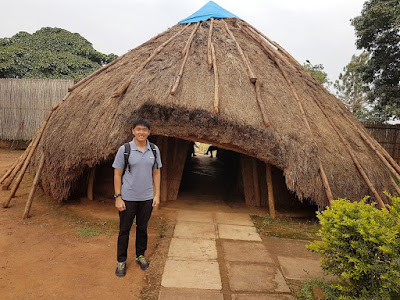Cankurtaran District, Istanbul, Turkey
Wed-Mon: 9.00am - 5.00pm (winter) or 7.00pm (summer)
Six years after the conquest of Constantinople, the construction of Topkapi Palace began in 1459 under the order of Mehmed the Conqueror. Originally known as Yeni Sarayi (lit. New Palace) to distinguish it from the Old Palace at Beyazit Square, Topkapi Palace served as the main residence and administrative headquarters of sultans of the Ottoman Empire.
 |
| Walking through the Imperial Gate~ |
At the point of writing, the entrance fee is ₺40.00 (~S$12.40), which is included under Istanbul Museum Pass, but it doesn't cover the Harem and Dormitory of the Halberdiers with Tresses. An additional fee of ₺25.00 (~S$7.75) applies in order to visit the latter, which I didn't go for.
 |
| Estimates of the total area of the complex varies from 592,600 to 700,000 square metres. |
 |
| The palace kitchen is truly interesting, but no photography is allowed inside. |
The palace has got four courtyards. The Gate of Felicity marks the entrance to the third courtyard, which comprises the private and residential areas of the palace complex. In the past, no one could pass the gate without the approval of the reigning sultan.
 |
| Seen at the gate is the gate is a dome supported by lean marble pillars. |
Right behind the gate is the Chamber of Petitions, which houses the main throne room. According to an account by Cornelius de Schepper in 1533, "the Emperor was seated on a slightly elevated throne completely covered with gold cloth, replete and strewn with numerous precious stones, and there were on all sides many cushions of inestimable value; the walls of the chamber were covered with mosaic works spangled with azure and gold; the exterior of the fireplace of this chamber of solid silver and covered with gold, and at one side of the chamber from a fountain, water gushed forth from a wall".
 |
| The building was destroyed by fire in 1856, but rebuilt during the reign of Sultan Abdulmecid I. |
Nearby is the Imperial Council building where many people sought shelter from the midday sun.
 |
| I wonder if those are names of the people in the de facto cabinet of the Ottoman Empire |
 |
| Such an ornate place to hold meetings~ |
Behold, a breathtaking view from the palace grounds!
 |
| "I am sailing stormy waters to be with you, to be free~" |
I can't exactly find a concrete information, but the beautiful Yerevan Kiosk is presumably named so when Sultan Murad IV led his army to capture Yerevan in Western Armenia in 1635.
 |
| It used to be a place for relaxation for the sultans. |
The Baghdad Kiosk was built to commemorate the recapture of Baghdad, which is the capital city of modern Iraq, Sultan Murad IV in 1638.
 |
| The facade is covered with marble, strips of porphyry and verd antique. |
 |
| The Iftar Bower is a small gilded pavilion in front of the Baghdad Kiosk. |
Don't you love the blue colours shown below?
Before I left the premises, I saw the following biped and was somehow so determined to take a picture of it. It wasn't easy, I must say, as it kept moving at a considerably high speed. Apparently, there was a Turkish man who'd been observing me and said that I should catch and fry it. Haha...
Don't forget to drop by the Imperial Treasury, which boasts one of the richest assemblages of Islamic arms in the world across the centuries. Unfortunately, it's another venue where photography is forbidden.


















































Comments
Post a Comment